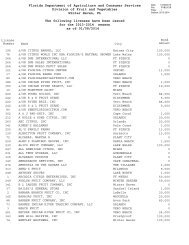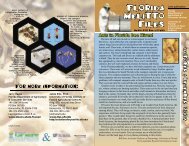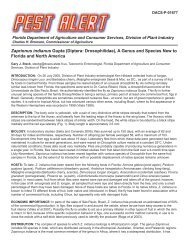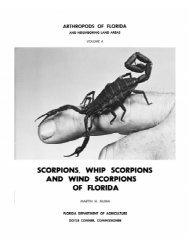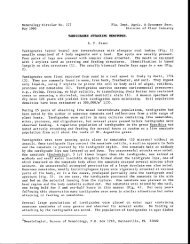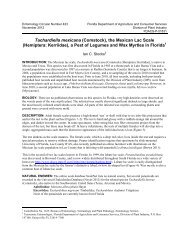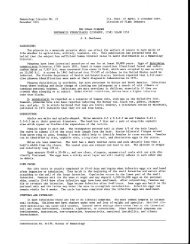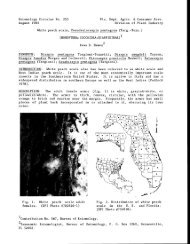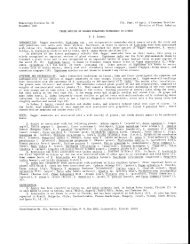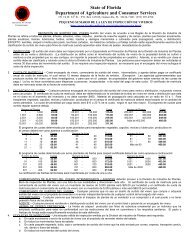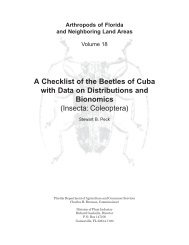Contribution No. 529, Bureau of Plant Pathology, P. 0. Box 1269 ...
Contribution No. 529, Bureau of Plant Pathology, P. 0. Box 1269 ...
Contribution No. 529, Bureau of Plant Pathology, P. 0. Box 1269 ...
Create successful ePaper yourself
Turn your PDF publications into a flip-book with our unique Google optimized e-Paper software.
<strong>Plant</strong> <strong>Pathology</strong> Circular <strong>No</strong>. 242 Fla. Dept. Agric. & Consumer Serv.<br />
<strong>No</strong>vember 1982 Division <strong>of</strong> <strong>Plant</strong> Industry<br />
DOTHICHIZA LEAF SPOT OF BLUEBERRIES<br />
S. A. Alfieri, Jr.<br />
INTRODUCTION. Blueberries are native to several areas in the United<br />
States, including the Atlantic coastal states. The rabbiteye blueberry,<br />
Vaccinium ashei Reade, is native to the southeastern United States and occurs<br />
along large streams in northern Florida and southeastern Alabama and Georgia.<br />
The highbush types (V. corymbosum L. and V. australe Small) are grown extensively<br />
in New Jersey, <strong>No</strong>rth Carolina, and Michigan (2). Blueberry cultivation in<br />
Florida has grown from 50 acres in 1974 to 300 acres at present (C. E.<br />
Arnold, Univ. <strong>of</strong> Fla., pers. comm.). The rabbiteye cultivars best suited for<br />
Florida in descending order are 'Climax', 'Woodard', 'Aliceblue', 'Beckyblue',<br />
'Delite', and 'Bluebell'--the highbush cultivars include 'Sharpblue',<br />
'Avonblue' and 'Flordablue' (Paul M. Lyrene, Univ. <strong>of</strong> Fla., pers. comm.). Acid<br />
(pH 4.5 to 5.5), well-drained soils are best suited for blueberry production<br />
(1,2,4). Blueberries are also intolerant <strong>of</strong> nitrate fertilizers and weed<br />
competition (4).<br />
Blueberries are affected with a number <strong>of</strong> disease problems (1,2,3,5,6,7). Of<br />
these, Dothichiza caroliniana Demaree & Wilcox (3,5,7) is reported to cause a<br />
leaf spot or 'double spot' that can be <strong>of</strong> minor to moderate significance on<br />
some cultivars. Its pathogenicity was subsequently established by Taylor and<br />
Clayton (7). The inoculum overwinters in fallen leaves and on infected stems<br />
(5). In <strong>No</strong>rth Carolina it was reported to be <strong>of</strong> widespread occurrence and<br />
damaging among cultivated varieties <strong>of</strong> highbush blueberry (3). This disease<br />
frequently defoliates susceptible blueberry cultivars (5).<br />
Fig. 1. Dothichiza leaf spot <strong>of</strong> rabbiteye blueberry caused by<br />
Dothichiza caroliniana. (DPI Photo #702627)<br />
<strong>Contribution</strong> <strong>No</strong>. <strong>529</strong>, <strong>Bureau</strong> <strong>of</strong> <strong>Plant</strong> <strong>Pathology</strong>, P. <strong>0.</strong> <strong>Box</strong> <strong>1269</strong>, Gainesville, FL<br />
32602.
SYMPTOMS. Leaf spots caused by Dothichiza caroliniana are initially<br />
characterized by pinpoint, dark brown lesions which enlarge to circular or<br />
subcircular brown spots up to 3 mm in diameter, with a dark brown margin and a<br />
slight, diffuse yellow halo (Fig. 1). Leaf spots tend to enlarge, hence the<br />
name 'double spot'. It is possible that varietal differences in susceptibility<br />
to the pathogen exist. For example, <strong>of</strong> three cultivars recently observed at a<br />
commercial outlet, the rabbiteye cultivars 'Homebell' and 'Tifblue' had a few to<br />
a moderate number <strong>of</strong> lesions (1 to 10) per leaf, with 'Tifblue' having fewer and<br />
smaller lesions, whereas the rabbiteye cultivar 'Climax' had none.<br />
CONTROL. Benlate is recommended for control <strong>of</strong> leaf spot diseases <strong>of</strong><br />
blueberry and should be applied according to manufacturer's recommendations, if<br />
the disease is serious. Captan, Dyrene, and zineb are also registered for use on<br />
blueberries (T. A. Kucharek, Univ. <strong>of</strong> Fla., pers. comm.).<br />
SURVEY AND DETECTION. Look for the onset <strong>of</strong> dark brown, discrete, pinpoint<br />
leaf spots, which progress to a lighter brown with a slight halo and enlarge<br />
up to 3 mm in diameter on the more mature leaves.<br />
LITERATURE CITED<br />
1. ARNOLD, C. E., and SHERMAN, W. B. 1974. Growing blueberries in Florida.<br />
Univ. Fla., Coop. Ext. Serv. Circ. 397. 8pp.<br />
2. BRIGHTWELL, W. T. 1971. Rabbiteye blueberries. Univ. Georgia, Coll.<br />
Agric. Exp. Res. Stn. Res. Bull. 10<strong>0.</strong> 20 pp.<br />
3. DEMAREE, J. B., and WILCOX, MARGUERITE S. 1947. Fungi pathogenic to<br />
blueberries in the eastern United States. Phytopathology 37:487-505.<br />
4. LYRENE, P. 1981. Blueberry varieties for Florida. Florida Grower and<br />
Rancher. 74(9):7-9.<br />
5. MILHOLLAND, R. D., JONES, R. and CLAYTON, C. N. 1974. Blueberry diseases in<br />
<strong>No</strong>rth Carolina. <strong>No</strong>rth Carolina Agric. Ext. Serv. Circ. 466. 15 pp.<br />
6. TAYLOR, J. 1958. Stem canker and related blueberry diseases. <strong>No</strong>rth<br />
Carolina Agric. Exp. Sta. Tech. Bull. 132. 24 pp.<br />
7. TAYLOR, J., and CLAYTON, C. N. 1959. Comparative studies on Gloeosporium<br />
stem and leaf fleck and Dothichiza leaf spot <strong>of</strong> highbush blueberry.<br />
Phytopathology 49:65-67.



